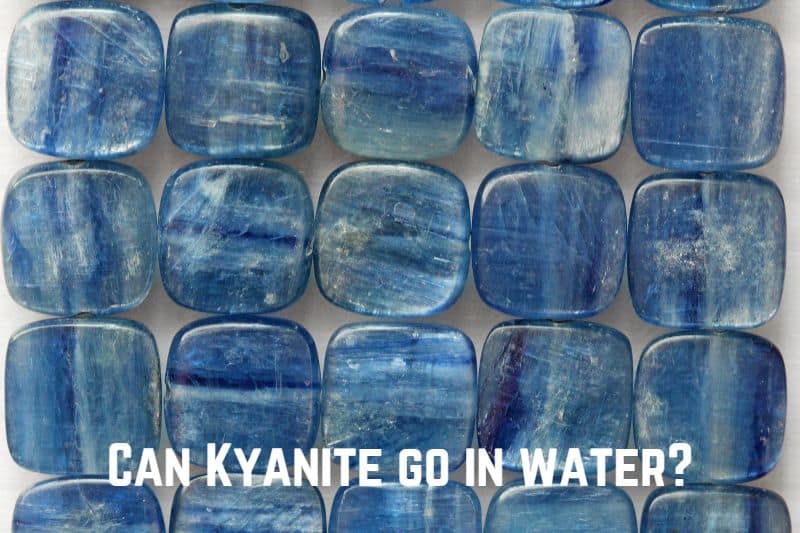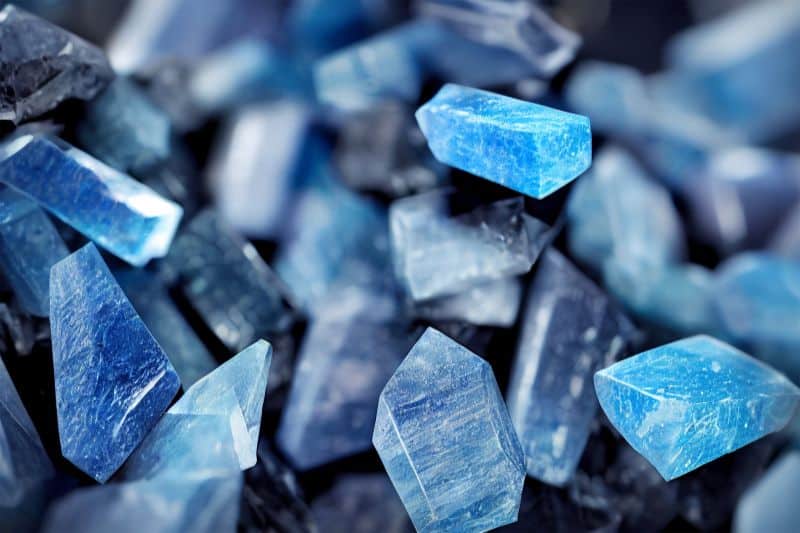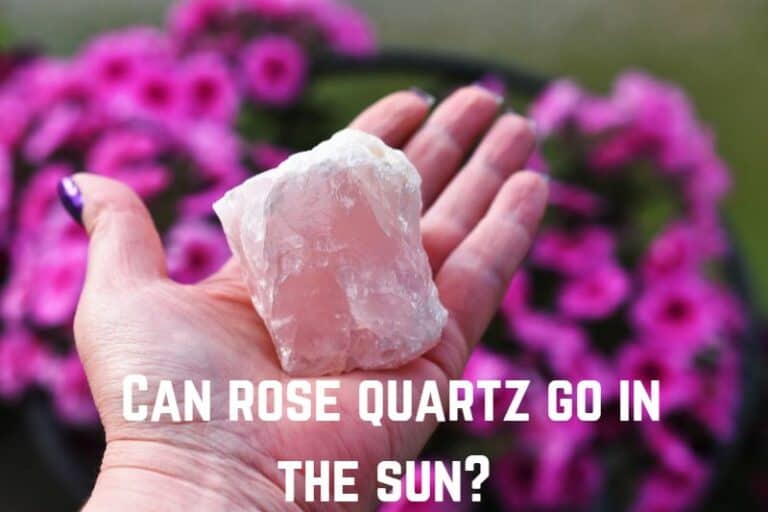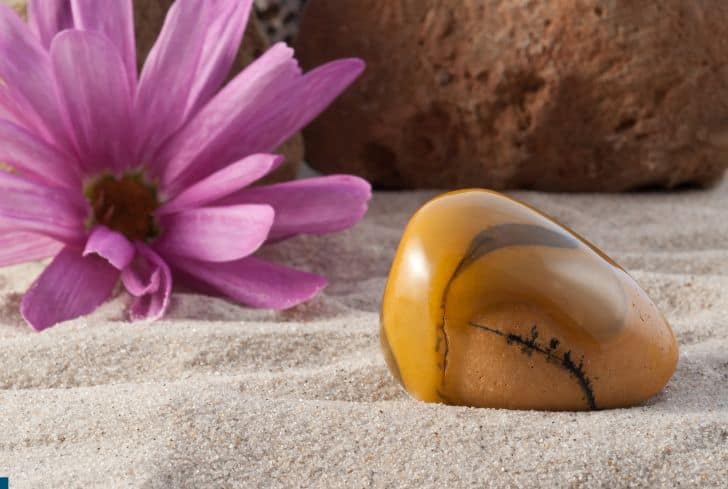Can Kyanite Go in the Water? (No…)

Kyanite is a blue aluminosilicate mineral. Its name is derived from the Greek word κύανος (meaning “dark blue”), just like the name of the color cyan. Kyanite is used as a gemstone, in industrial applications, and by geologists.
Have you ever wondered if kyanite can go in the water? In this article, we are going to discuss just that. We will talk about its interaction with water, moon water, and sunlight. Then we will also talk about its properties & uses, while also understanding how to identify an authentic kyanite.
Read: Can Serpentine Go in the Water?
Can Kyanite Go in the Bathwater?
No, Kyanite is not safe to go in the bathwater. It is an anisotropic mineral, meaning its hardness varies across its surface. One side of the stone has a hardness of around 4.5-5.0, which is less than the minimum value required for minerals to be safe underwater. Therefore, kyanite should not be immersed.
Mohs Hardness Scale is a relative measure of a mineral’s resistance to scratching. Besides that, it also indicates a stone’s relationship with water. Usually, a value over 5.0 implies that the stone is safe for immersion.
Kyanite has a unique property known as anisotropy, meaning that its hardness depends on its crystallographic direction. It has a hardness of around 4.5 to 5.0 parallel to the {001} axis, while the plane parallel to the {100} axis has a hardness of 6.5-7.0.
So, even if one side of the stone may be strong enough to withstand water, the other side will get damaged by it. In general, no stone should be immersed in water for too long. Water enters the crevices of stones, expanding their cracks.
These fissures can slowly damage the structure of the stone, making it prone to cracking. Water also tarnishes the appearance of stones. It strips off the polish from their surface, making them look duller. Kyanite is especially known for its gorgeous blue color, so we don’t want this to happen.
Therefore, it is best to avoid using water for kyanite. Instead, you can go for other cleansing methods, which we will discuss below.
Can Kyanite Go in Saltwater?
No, Kyanite should never be put in salt water. Even normal water is dangerous for kyanite because some sides of the stone are too soft and will get damaged during immersion. Salt makes the corrosion even worse.
When dissolved in water, salt can seep into the crevices of the stone. Salt particles remain there even after the water evaporates, and they widen the cracks. These fissures can slowly damage the structure of the stone.
Salt water also tarnishes the appearance of the stone by stripping off the polish—this is especially bad for kyanite, whose radiant blue color (along with optical properties) is its main attraction. Finally, salt can also react adversely with the elements of the mineral, especially those having iron.
Saltwater hastens the process of rusting by making the metal lose its electrons more easily. Therefore, it is best not to immerse kyanite in salt water.
Can Kyanite Go in Moon water?
No, Kyanite should not be put in moon water. Kyanite has varying levels of hardness, and not all of its surfaces are resistant to water. So, even though placing stones in moon water is a popular method, it should not be used for kyanite.
Moon water is water that has been charged by moonlight, which captures the gentle energies of the moon. It is common to immerse stones in moon water and leave them for a while; the stone then gets recharged with the moon’s strength.
However, this method is not safe for all stones. Kyanite is certainly not meant for this as some of its surfaces have a hardness as low as 4.5. This is well below the minimum value of 5.0 required for minerals to be safe underwater.
Therefore, kyanite should not go in moon water.

Can Kyanite Go in the Sun?
Yes, Kyanite can go in the sun. Placing stones out in the sunlight is another popular way of recharging them, and it is perfectly safe for kyanite. However, make sure you do not leave it out for too long.
Keeping stones out in the sunlight is a fast and easy way of recharging your stones. To charge your kyanite with the strength of the sun, simply place it outdoors or on a window sill for about 30 minutes.
The direct sunlight of a sunny day is ideal for kyanite, but a cloudy day would also be fine. You can also try leaving your stone out during both dawn and dusk. This way, it will capture the energies of both the moon and the sun.
How Can You Tell if Kyanite is Real?
The best way to identify real Kyanite is by checking if the stone is anisotropic. This means that you need to find out if the stone has different levels of hardness across its surface.
Kyanite’s anisotropy is its most distinguishing feature. The plane parallel to {001} axis has a hardness of 4.5-5.0 while the one parallel to {100} axis has a value of around 6.5-7.0. Touch the stone to ascertain if it has different levels of hardness.
If it does, then it is most likely kyanite. Moreover, even though scientists have discovered ways to make scientific kyanite, it is not done on a major scale. This is because the varying hardness of the stone makes it hard to cut, which is why making a large quantity of the synthetic version is not economically viable.
Finally, kyanite is not a rare material. Therefore, the chances of duplicating it are quite less.
Properties of Kyanite
These are the properties of kyanite:
- Appearance: Kyanite is typically blue, but some specimens can be clear, green, black, or purple. Some kyanite stones are even pleochroic, meaning that they appear to be of different colors when viewed from different directions. The stones range from translucent to transparent, and the most prized pieces are transparent with a deep sapphire-blue color.
- Composition & Occurrence: Kyanite is an aluminosilicate mineral and has the chemical formula of Al2SiO5. It is mainly found in metamorphic rocks that are formed at high pressure during the regional metamorphosis of an aluminum-rich protolith. Sometimes, it is also found in granite and pegmatites, and rarely in eclogites.
- Thermal Expansion: Unlike most other minerals, kyanite can expand significantly when heated. It can grow up to twice its size, depending upon the stone’s size and heating conditions. This property helps in the manufacture of refractory materials, where kyanite is added to the raw material (this shrinks during heating) to maintain volume.
Uses of Kyanite
Kyanite has various uses such as:
- Gemstone: Kyanite is not commonly found in jewelry stores but is an “exotic” gem. Cutting it is slightly difficult (due to varying hardness), but experts can turn it into beautiful cabochons and faceted stones. Rings, earrings, and pendants can also be made.
- Industrial Uses: Kyanite is widely used in the manufacture of refractory products, such as the bricks and mortars used in high-pressure furnaces. It is also used in automotive and railroad industries where heat resistance is crucial.
- Index Material: Kyanite is an important index material that presence helps geologists to identify metamorphic zones.
How to Cleanse Kyanite?
Kyanite is not safe to be put in water. It has varying levels of hardness, and some of its surfaces have a value of 4.5 on the Mohs Hardness Scale, which is less than the minimum value (5.0) required for minerals to be safe underwater. Therefore, we need to use other methods to cleanse the stone:
- Moonlight: Earlier, we had discussed how sunlight can be used for cleansing kyanite, and similarly, moonlight is also a great source. Just keep your stone on a windowsill that receives strong moonlight and leave it overnight. For best results, you should do this on a full moon night.
- Brown Rice: Another effective and easy way to cleanse your crystals is brown rice. Simply fill a bowl with dry, uncooked brown rice, and then place your kyanite stone on top of it. You can put more rice to completely cover the stone. Leave it there for 24 hours and the rice will absorb all the negative energy of the stone. Make sure you throw away the rice after use.
- Earth: Earth is a great natural cleanser of stones. Dig a small hole out in your garden or any other nearby area, and bury the stone in it completely. You can leave the stone buried for a few days. Then take it out, rinse it quickly, and then pat it dry.
Read: Can Peridot Go in the Water?
Conclusion
In this article, we have discussed kyanite’s interaction with water, moon water, and sunlight. Being an anisotropic mineral, kyanite has varying levels of hardness and is therefore not safe to go underwater. It can be cleaned by other methods, such as moonlight, brown rice, etc. We also looked at the properties and uses of the stone.






